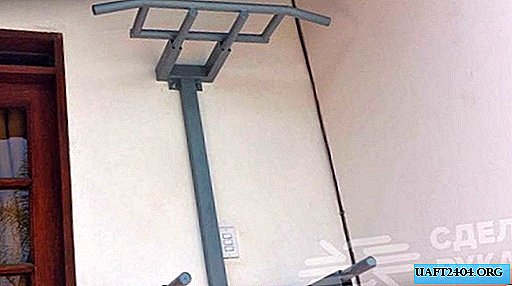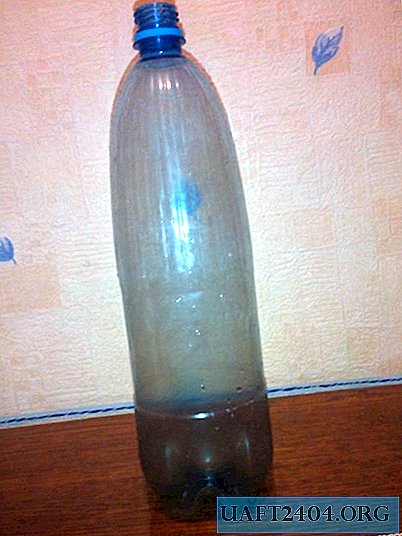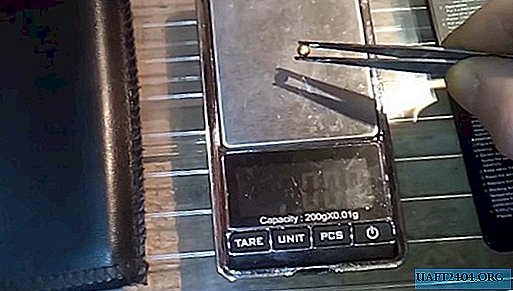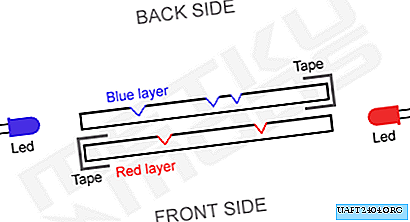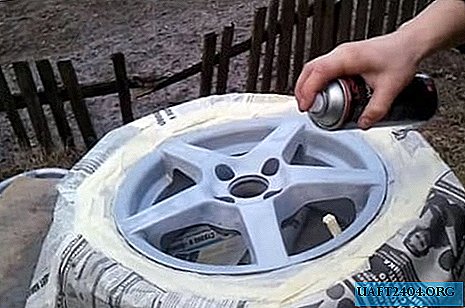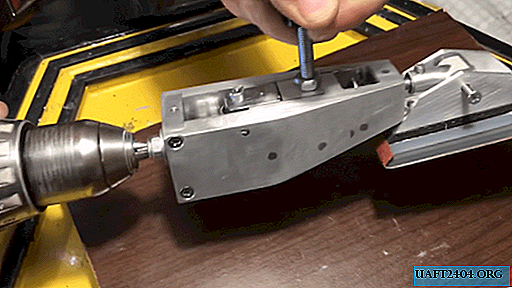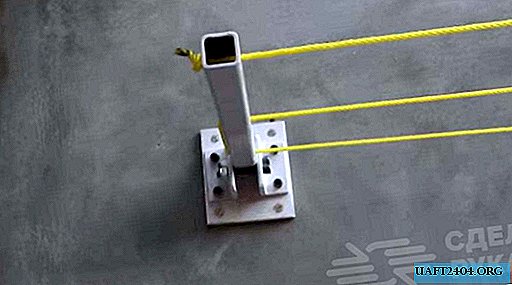Share
Pin
Tweet
Send
Share
Send
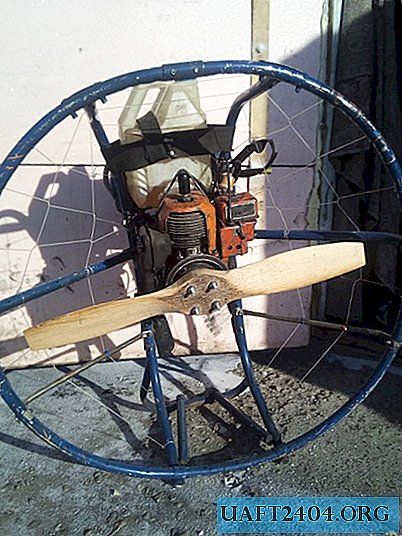
The device, hereinafter referred to as the satchel, is intended for movement on ordinary skis on a flat surface without a thick, fluffy snow cover.
Frozen river floodplains, rolled roads with a slight slope are best suited.
In addition, the satchel, with small tweaks, can be used as a mover on an inflatable boat. Of course, the boat will not go against the current on the mountain river - the strength is not enough, but along the calm river, or with a small current, the “gum” goes very well.
Now, about creation. I used exclusively improvised materials: the old cot, scraps of the conveyor belt, fishing line 1.5 mm, scraps of 2 mm strip, fasteners - screws and nuts M5-M6.
It will be required:

- Chainsaw "Ural", or rather - the engine from it.
- Aluminum pipe with a diameter of 20 mm.
- Met. strip or sheet 1.5-2mm.
- Screws of different lengths M5, M6 and washers with nuts.

- 4 furniture bolts M8x65 with washers and nuts.
- Conveyor belt 20x20cm.
- fishing line 1.5 mm.
- Dry pine board with a minimum of knots 80x10x10.5cm for the propeller.
- Drill.
- Hacksaw for metal.
- Screwdriver, keys, pliers, file, etc.
So. Without claiming the ultimate truth.
Manufacture
The motor itself does not require practically any special alterations from the saw. Unless, removing the studs of the fan cover fastening and replacing them, after drilling through holes, with long (70mm) M6 bolts.

And yet, we disassemble the drive disk of the centrifugal clutch (remove the load with the springs).


And squander files with a square, for the possibility of a tight fit in them furniture bolts.
Pre-grind semicircular bolt caps to a thickness of 3 mm. Otherwise, they will cling to the studs of the crankshaft seal.

It should be like this. More, so far, nothing is required. Next we build an engine mount with a motor and propeller guard.
It looks like this:

Since I made it from an old clamshell, there were no special difficulties with bending the tubes. First, two identical vertical posts are manufactured (FIG. 1). Then, motor tubes (Fig. 2) are attached to them with screws M6, (Fig. 3) using washers and self-locking nuts or with locknuts.

Mounting the engine should also not cause questions. To reduce vibration, it is attached to the strips of the conveyor belt, exactly, on those long bolts that replaced the studs for attaching the fan cover.
To make a propeller guard ring, an aluminum hula hoop would do best. I had to pretty mess around with pipes from the same clamshell. They are very strong in bending, and in addition - short, which did not contribute to the facilitation of giving the desired radius.

We turn to the horizontal parts of the fence (figure 5). The upper ones are made of aluminum, the lower ones are made of stainless steel (there wasn’t enough clamshell).
Mounted like this: a metal U-shaped strip and M5 screws. To vert. racks - similarly.

In the upper and lower parts, the ring is attached to the uprights by rounded triangular plates of metal 1.5 mm thick. For ease of starting, a stop is attached to the vertical posts below. It can be done to anyone like and from what you like. But the straps to hold the satchel on my back, it is better to do just those - like mine. From a pipe, flattened in the place of rounding the shoulders, followed by wrapping with foam rubber and putting on a fabric cover. The straps are also attached to the conveyor belt to the tubes of the engine mount, or to an additional tube horizontally fixed to the uprights. Why on conveyor? Vibration is less and it is easier to put on a satchel on a back. It is checked on itself.
About fixing the starter.

In the place indicated by the arrow, or vice versa (above or below), a hole for M5 thread is drilled. After installing the starter on the motor, tighten the M5 screw with a lock nut. As an option - a self-tapping screw. This will prevent the starter from disconnecting from the engine.
ORE. (engine control knob)

To control the throttle, I used the gas cable from the motorcycle, which, together with the engine shutdown wire, is placed in the metal hose, which is also a "minus", since it is fixed with a clamp or plastic ties to a vertical strut and accordingly has a connection with the motor case.
But the pen itself was made as follows.
A piece of tube was taken with a length of 135 mm, around which a strip of aluminum 20X100 mm and a thickness of 2 mm was wrapped.
- Handle tube.
- Lever control other flap.
- A wooden or plastic plug drilled across at the same time as the pipe.
- U-shaped clamp of fastening of the lever.
- U-hole for mounting screw clamp
- Lever screw hole.
- The sheath of the gas cable.
- Engine stop wire.
- Throttle cable.
- Stop Button
- Gas cable boss hole.
This is what RUD looks like.

The “Stop” button ((in my case, the key) made on the throttle, is connected with a standard “jammer” of the motor with one wire, the metal sleeve plays the role of the second wire. The native engine stop button is dismantled.
In the role of the fuel tank - a 3-liter canister, with a fuel tap mounted from the same Ural. You can get by with a "primer" from imported chainsaws by installing it on the fuel tank cap.
One indispensable condition is that the tank must be ABOVE the carburetor. There is no fuel priming pump in the Urals, and it is needed only for a stable supply of gasoline with very strong saw tilts.
I refused my native gas tank because of the inability to control the level in it.
In order to prevent foreign objects (parts of clothes, hands, finally) from getting into the propeller, it is EXTREMELY necessary to make protection from a thick (1.5 mm) fishing line.
Another option: use a pre-fabricated, coarse mesh network. I didn’t have one, therefore I needleworked from a fishing line.
ATTENTION!!! I do not advise, even trying, to test a satchel with an installed propeller (although I really want to) without an installed mesh fence! Firstly, there is a chance, by accident, to crawl with your hand into the "invisible" rotating screw from the motor side. (IT HAPPENED!).
Secondly, it can tighten foreign "flying" objects. For example, I had already worn a device on my shoulders, turned in a split second, the floor of the jacket into evenly cut ribbons. At 6,000 rpm. The pine screw works like a razor.
Well, that's probably all about the knapsack.
Now about the screw, the propeller.
Making it, in general, also does not cause much difficulty.
The network has a lot of video materials. Here is the link - //paraplan.ru/forum/post/658794
A detailed description of the creation.
- The second option is to order on Aliexpress. The price is about 2.5t.
- Diameter - 65 cm
- Screw pitch - 21 cm.
- Of all the tested, other options, this turned out to be the most productive.
- The thrust, with the carburetor adjusted, was slightly less than 20 kg.
- For paragliding, this is not enough, even “on the horizon”, but on skis: on the infusion, on the road - 40 km / h, on the shallow “puff” - 20 km / h, and on the broken track - 30 km / h. According to the testimony of the GPS navigator.
- Consumption - as in the "Urals" when sawing: 0.8 l / h.
Feel? Not transferable! The unusual thing is that you are not pulled forward, but pushed into the back. Unusual, but quickly mastered.
Video of my trials
GOOD LUCK!
Share
Pin
Tweet
Send
Share
Send

